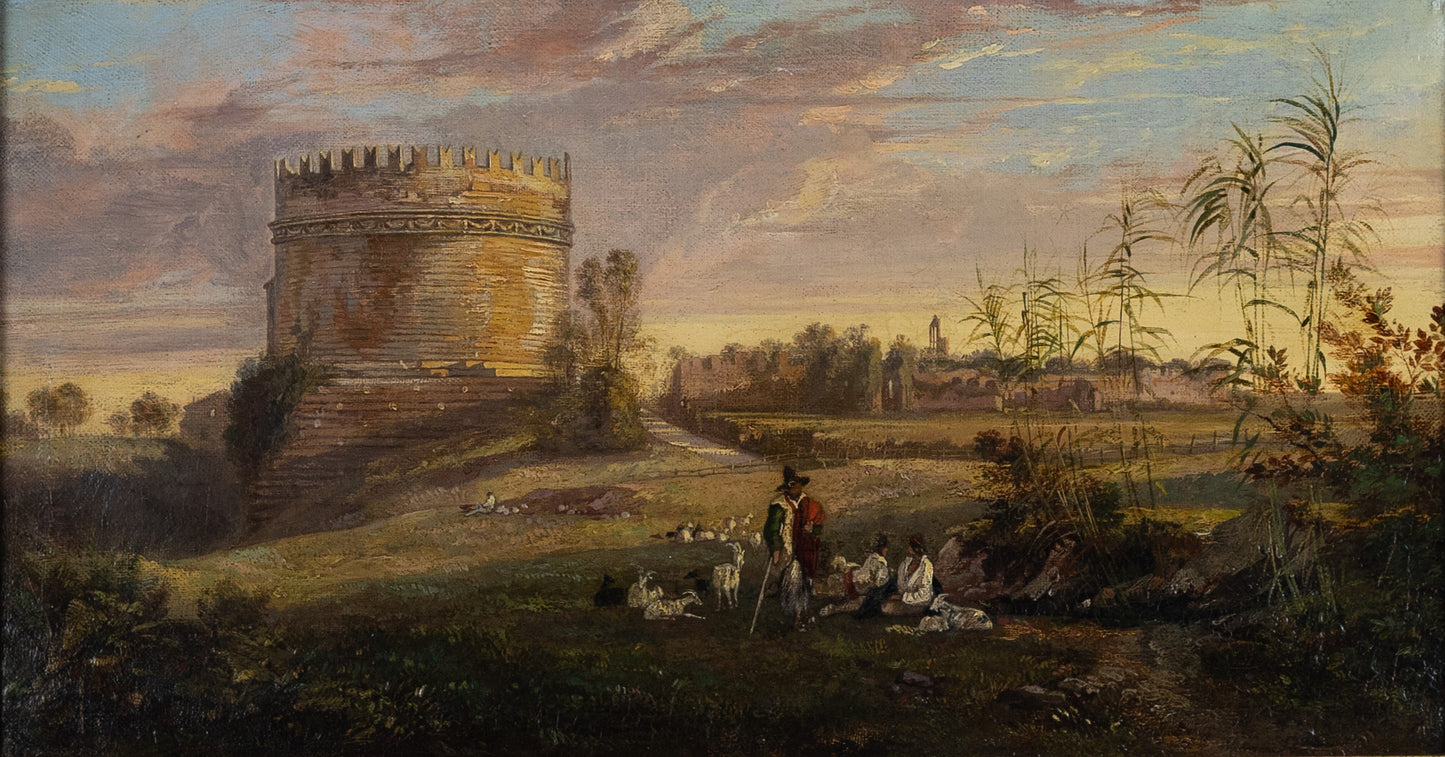LEAR, Edward (British, 1812-1888). The Tomb of Cecilia Metella on the Via Appia, Rome. ca. 1842.
LEAR, Edward (British, 1812-1888). The Tomb of Cecilia Metella on the Via Appia, Rome. ca. 1842.
Couldn't load pickup availability
Edward Lear (British, 1812-1888)
The Tomb of Cecilia Metella on the Via Appia, Rome
Oil on canvas
Signed "1842/Ed Lear"
9" x 17 1/2" canvas, 18 1/2" x 26 1/4" framed
Provenance: Painted for Captain and Miss Phipps Hornby of Shooters Hill, Kent; Miss Edith Jones, and thence by descent.
During the nineteenth century, artists and tourists alike flocked to Italy to observe the country's countless ruins and bask in its mythical golden sunlight. Edward Lear (1812-1888), author of books of nonsense, purveyor of limericks, and prolific creator of exquisite landscape art, captures both Italian wonders within these two marvelous paintings of the Roman environs. The first, The Tomb of Cecilia Metella on the Via Appia, Rome (1842), depicts the final resting place of the Roman Consul Creticus' daughter and member of the first Roman Triumvirate Crassus's son's wife. The tomb, whose occupant Cecilia Metella died in 50 B.C., is located on the Via Appia, the most important ancient Roman road connecting the Italian capital to Brindisi, Apulia in southeast Italy. The second work, The Tor di Schiavi on the Via Labicana, Rome (1842) illustrates the remains of an extensive villa built during the time of Diocleation and is situated on another chief Roman thoroughfare.
Edward Lear was born into a middle-class family at Holloway, North London, the penultimate of twenty-one children (and youngest to survive) of Ann Clark Skerrett and Jeremiah Lear. He was brought up by his eldest sister, also named Ann, twenty-one years his senior. Owing to the family’s limited finances, Lear and his sister were required to leave the family home and live together when he was aged four. Lear suffered from lifelong health afflictions starting from the age of six, his ailments included frequent grand mal epileptic seizures, and bronchitis, asthma, and during later life, partial blindness.
Lear was already drawing “for bread and cheese” by the time he was aged sixteen and soon developed into a serious “ornithological draughtsman” employed by the Zoological Society and then from 1832 to 1836 by the Earl of Derby, who kept a private menagerie at his estate, Knowsley Hall. He was the first major bird artist to draw birds from real live birds, instead of skins. Lear’s first publication, published when he was nineteen years old, was Illustrations of the Family of Psittacidae, or Parrots in 1830. One of the greatest ornithological artists of his era, he taught Elizabeth Gould while also contributing to John Gould’s works and was compared favorably with John James Audubon.
In 1842, Lear began a journey into the Italian peninsula, traveling through Lazio, Rome, Abruzzo, Molise, Apulia, Calabria, and Sicily. In personal notes, together with drawings, Lear gathered his impressions on the Italian way of life, folk traditions, and the beauty of the ancient monuments. He eventually settled in San Remo, on his beloved Mediterranean coast, in the 1870s, at a villa he named “Villa Tennyson.”
Among other travels, he visited Greece and Egypt during 1848–49, and toured India during 1873–75, including a brief detour to Ceylon. While traveling he produced large quantities of colored wash drawings in a distinctive style, which he converted later in his studio into oil and watercolor paintings, as well as prints for his books. His landscape style often shows views with strong sunlight, with intense contrasts of color.
Throughout his life Lear continued to paint seriously, even as his health steadily declined. He had a lifelong ambition to illustrate Tennyson’s poems and in the final years of his life a volume with a small number of illustrations was published.
Lear died at his villa in 1888 of heart disease, from which he had suffered since at least 1870.
Lear as Author
In 1846, Lear published A Book of Nonsense, a volume of limericks that went through three editions and helped popularize the form and the genre of literary nonsense. In 1871, he published Nonsense Songs, Stories, Botany and Alphabets, which included his most famous nonsense song, “The Owl and the Pussycat,” which he wrote for the children of his patron Edward Stanley, 13th Earl of Derby. Many other works followed.
Lear’s nonsense books were highly popular during his lifetime, but a rumor developed that “Edward Lear” was merely a pseudonym, and the books’ true author was the man to whom Lear had dedicated the works, his patron the Earl of Derby. Promoters of this rumor offered as evidence the facts that both men were named Edward, and that “Lear” is an anagram of “Earl.”
Lear’s nonsense works are distinguished by a facility of verbal invention and a poet’s delight in the sounds of words, both real and imaginary. A stuffed rhinoceros becomes a “diaphanous doorscraper.” A “blue Boss-Woss” plunges into “a perpendicular, spicular, orbicular, quadrangular, circular depth of soft mud.” His heroes are Quangle-Wangles, Pobbles, and Jumblies. One of his most famous verbal inventions, the phrase “runcible spoon,” occurs in the closing lines of The Owl and the Pussycat and is now found in many English dictionaries.






